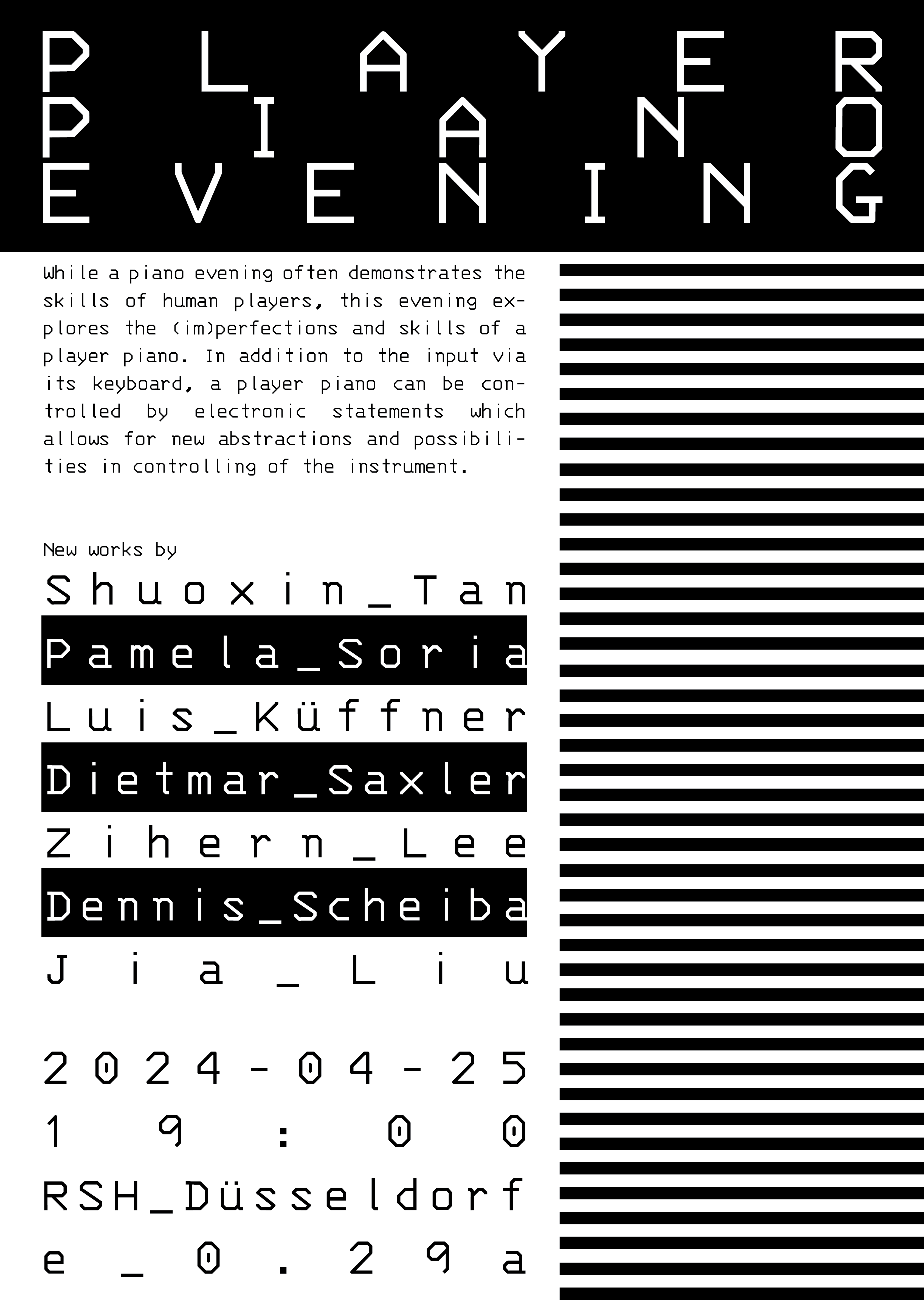# Evening for Player Piano
<style>
.ui-infobar, .ui-affix-toc, h1 {
display: none !important;
}
body {
// background-color: #eee;
font-family: monospace !important;
}
p, h1, h2, h3 {
font-family: monospace !important;
}
</style>

**Place:** e_0.29a (E-Gebäude)
**Time:** Thursday, 25.04.2024 @ 19:00h
While a piano evening often demonstrates the skills of human players, this evening explores the (im)perfections and skills of a player piano. In addition to the input via its keyboard, a player piano can be controlled by electronic statements which allows for new abstractions and possibilities in controlling of the instrument.
People from RSH Düsseldorf, UdK Berlin and ZKM Karlsruhe have created new pieces and performances for this event, which will be accompanied by some classic pieces for player piano.
The pieces will be performed on the prestigious *Steinway Model d sprio r* of the RSH, one of the best grand pianos owned by the RSH, which allows not only automated playback, but also recording of its keyboard input in high resolution.
In order to allow free movement of the audience and to increase the capacity, no seating will be provided.
## Program
### Shuoxin Tan: Voice$ and Piano
> 4 miniature compositions
Melodic transcription for player piano of 4 quotations from speeches by Felix Ensslin, Clarence Barlow, John Cage, and Fjodor Gladilin.
### Pamela Soria Sanchez: Mittel und Zweck
> Three short pieces that explore different approaches to use a musical instrument.
This piece tries to analyse whether this majestic piano marks a new generation of fine Automata that aim to entertain and impress, or if this instrument can also be taken as a tool to create new compositions that approach piano playing and live performances differently.
Is this instrument a means to an end? Or is it both? Let the audience decide.
### Luis Küffner: Imperfections
A player piano embodies values such as precession, perfection, and efficiency. Imperfections tries to express the exact opposites of those.
### Dietmar Saxler: 2 Mantras
> 2 mantras for piano, composed by Lubomyr Melnyk.
The pianist Lubomyr Melnyk composed several mantras for my master’s thesis “How does God sound?”. Melnyk is considered the inventor of “continuous music”. The two mantras are typical of his style of composition.
### Conlon Nancarrow: 4 Studies for Player Piano
Studies #6, #7, #19, #21
Conlon Nancarrow composed primarily for a modified player piano controlled by punched cards. His studies emphasize the juxtaposition of phasing patterns and varying tempos, creating a wild storm of keystrokes that create a new sonic landscape that escapes the traditional sonorities of a piano.
Although the *spirio r* is a magnificent piano, it is not up to the demands of Nancarrow's prepared player piano, so a more tamed version will be performed.
György Ligeti was a great admirer and supporter of Nancarrow's music, which also inspired Ligeti to compose for player piano and barrel organ.
Thanks to the efforts of Julian Rohrhuber and Clarence Barlow, who translated the punched cards, it is possible to play the studies via MIDI on this evening.
---
20 minute break
---
### Zihern Lee: 공백空白: Composition of rest III
> 20 minute performance
### Dennis Scheiba: A practicing player piano
Although every player spends a lot of time practicing piano, this is rarely shown in a public performance, as these *imperfections* are labeled as something un-finsihed of an idealistic set of instructions.
But instead of hiding this progression, *A practicing player piano* exposes this never-ending pursuit for something *idealistic*, something that can also be found in the *training* process of AI (where a result of an algorithm is compared to an ideal dataset, whose difference is then used to *tune* the algorithm) and in the tuning of a piano (where a reference tone is tried to be matched and tune its relations accordingly).
By analyzing datasets of performances and practice sessions on a piano, and combining this with an exploration of the mechanical limits of the player piano, the piece attempts to expose this pursuit, creating its own semantics of perfection and imperfection by sonifying how algorithms and mechanical parts practice.
### Jia Liu: unnumbered modes
> 10 minute performance
### Aphex Twin: aisatsana [102]
Originally composed for a player piano on a swing, this piece was released as the last song on Aphex Twin's 2014 release *Syro*.
Richard D. James has a long tradition of composing for computer-controlled instruments, such as the often sampled classic *Avril 14th* or his 2015 album *Computer Controlled Acoustic Instruments pt2 EP*.
In the original, the movement of the piano creates a natural phasing effect, but for this evening, the song will be performed without swing.